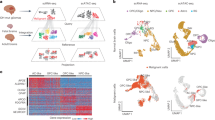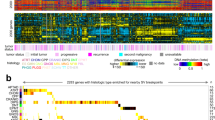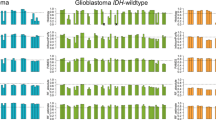Abstract
Both genome-wide genetic and epigenetic alterations are fundamentally important for the development of cancers, but the interdependence of these aberrations is poorly understood. Glioblastomas and other cancers with the CpG island methylator phenotype (CIMP) constitute a subset of tumours with extensive epigenomic aberrations and a distinct biology1,2,3. Glioma CIMP (G-CIMP) is a powerful determinant of tumour pathogenicity, but the molecular basis of G-CIMP remains unresolved. Here we show that mutation of a single gene, isocitrate dehydrogenase 1 (IDH1), establishes G-CIMP by remodelling the methylome. This remodelling results in reorganization of the methylome and transcriptome. Examination of the epigenome of a large set of intermediate-grade gliomas demonstrates a distinct G-CIMP phenotype that is highly dependent on the presence of IDH mutation. Introduction of mutant IDH1 into primary human astrocytes alters specific histone marks, induces extensive DNA hypermethylation, and reshapes the methylome in a fashion that mirrors the changes observed in G-CIMP-positive lower-grade gliomas. Furthermore, the epigenomic alterations resulting from mutant IDH1 activate key gene expression programs, characterize G-CIMP-positive proneural glioblastomas but not other glioblastomas, and are predictive of improved survival. Our findings demonstrate that IDH mutation is the molecular basis of CIMP in gliomas, provide a framework for understanding oncogenesis in these gliomas, and highlight the interplay between genomic and epigenomic changes in human cancers.
This is a preview of subscription content, access via your institution
Access options
Subscribe to this journal
Receive 51 print issues and online access
$199.00 per year
only $3.90 per issue
Buy this article
- Purchase on SpringerLink
- Instant access to full article PDF
Prices may be subject to local taxes which are calculated during checkout




Similar content being viewed by others
Change history
27 February 2012
The original supplementary figures PDF was corrupted and has been replaced.
References
Noushmehr, H. et al. Identification of a CpG island methylator phenotype that defines a distinct subgroup of glioma. Cancer Cell 17, 510–522 (2010)
Fang, F. et al. Breast cancer methylomes establish an epigenomic foundation for metastasis. Sci. Transl. Med. 3, 75ra25 (2011)
Toyota, M. et al. CpG island methylator phenotype in colorectal cancer. Proc. Natl Acad. Sci. USA 96, 8681–8686 (1999)
Yan, H. et al. IDH1 and IDH2 mutations in gliomas. N. Engl. J. Med. 360, 765–773 (2009)
Parsons, D. W. et al. An integrated genomic analysis of human glioblastoma multiforme. Science 321, 1807–1812 (2008)
Sjoblom, T. et al. The consensus coding sequences of human breast and colorectal cancers. Science 314, 268–274 (2006)
Mardis, E. R. et al. Recurring mutations found by sequencing an acute myeloid leukemia genome. N. Engl. J. Med. 361, 1058–1066 (2009)
Dang, L. et al. Cancer-associated IDH1 mutations produce 2-hydroxyglutarate. Nature 462, 739–744 (2009)
Figueroa, M. E. et al. Leukemic IDH1 and IDH2 mutations result in a hypermethylation phenotype, disrupt TET2 function, and impair hematopoietic differentiation. Cancer Cell 18, 553–567 (2010)
Ward, P. S. et al. The common feature of leukemia-associated IDH1 and IDH2 mutations is a neomorphic enzyme activity converting α-ketoglutarate to 2-hydroxyglutarate. Cancer Cell 17, 225–234 (2010)
Jones, P. A. & Baylin, S. B. The epigenomics of cancer. Cell 128, 683–692 (2007)
Ohm, J. E. et al. A stem cell-like chromatin pattern may predispose tumor suppressor genes to DNA hypermethylation and heritable silencing. Nature Genet. 39, 237–242 (2007)
Cheng, Y. W. et al. CpG island methylator phenotype associates with low-degree chromosomal abnormalities in colorectal cancer. Clin. Cancer Res. 14, 6005–6013 (2008)
Sonoda, Y. et al. Formation of intracranial tumors by genetically modified human astrocytes defines four pathways critical in the development of human anaplastic astrocytoma. Cancer Res. 61, 4956–4960 (2001)
Vivanco, I. et al. Identification of the JNK signaling pathway as a functional target of the tumor suppressor PTEN. Cancer Cell 11, 555–569 (2007)
Sonoda, Y. et al. Akt pathway activation converts anaplastic astrocytoma to glioblastoma multiforme in a human astrocyte model of glioma. Cancer Res. 61, 6674–6678 (2001)
Pieper, R. O. Defined human cellular systems in the study of glioma development. Front. Biosci. 8, s19–s27 (2003)
Bibikova, M. et al. High density DNA methylation array with single CpG site resolution. Genomics 98, 288–295 (2011)
Sandoval, J. et al. Validation of a DNA methylation microarray for 450,000 CpG sites in the human genome. Epigenetics 6, 692–702 (2011)
Mutskov, V. & Felsenfeld, G. Silencing of transgene transcription precedes methylation of promoter DNA and histone H3 lysine 9. EMBO J. 23, 138–149 (2004)
Bracken, A. P. et al. Genome-wide mapping of Polycomb target genes unravels their roles in cell fate transitions. Genes Dev. 20, 1123–1136 (2006)
Furnari, F. B. et al. Malignant astrocytic glioma: genetics, biology, and paths to treatment. Genes Dev. 21, 2683–2710 (2007)
Docherty, S. J. et al. Bisulfite-based epityping on pooled genomic DNA provides an accurate estimate of average group DNA methylation. Epigenetics Chromatin 2, 3 (2009)
Hegi, M. E. et al. MGMT gene silencing and benefit from temozolomide in glioblastoma. N. Engl. J. Med. 352, 997–1003 (2005)
Solomon, D. A. et al. Identification of p18INK4c as a tumor suppressor gene in glioblastoma multiforme. Cancer Res. 68, 2564–2569 (2008)
Etcheverry, A. et al. DNA methylation in glioblastoma: impact on gene expression and clinical outcome. BMC Genomics 11, 701 (2010)
The Cancer Genome Atlas Network Comprehensive genomic characterization defines human glioblastoma genes and core pathways. Nature 455, 1061–1068 (2008)
Lendahl, U., Zimmerman, L. B. & McKay, R. D. CNS stem cells express a new class of intermediate filament protein. Cell 60, 585–595 (1990)
Xu, W. et al. Oncometabolite 2-hydroxyglutarate is a competitive inhibitor of α-ketoglutarate-dependent dioxygenases. Cancer Cell 19, 17–30 (2011)
He, Y. F. et al. Tet-mediated formation of 5-carboxylcytosine and its excision by TDG in mammalian DNA. Science 333, 1303–1307 (2011)
Reich, M. et al. GenePattern 2.0. Nature Genet. 38, 500–501 (2006)
Verhaak, R. G. et al. Integrated genomic analysis identifies clinically relevant subtypes of glioblastoma characterized by abnormalities in PDGFRA, IDH1, EGFR, and NF1. Cancer Cell 17, 98–110 (2010)
Thomas, P. D. et al. PANTHER: a library of protein families and subfamilies indexed by function. Genome Res. 13, 2129–2141 (2003)
Rhodes, D. R. et al. Molecular concepts analysis links tumors, pathways, mechanisms, and drugs. Neoplasia 9, 443–454 (2007)
Subramanian, A. et al. Gene set enrichment analysis: a knowledge-based approach for interpreting genome-wide expression profiles. Proc. Natl Acad. Sci. USA 102, 15545–15550 (2005)
Vlassenbroeck, I. et al. Validation of real-time methylation-specific PCR to determine O6-methylguanine-DNA methyltransferase gene promoter methylation in glioma. J. Mol. Diagn. 10, 332–337 (2008)
Gordon, D., Abajian, C. & Green, P. Consed: a graphical tool for sequence finishing. Genome Res. 8, 195–202 (1998)
Nickerson, D. A., Tobe, V. O. & Taylor, S. L. PolyPhred: automating the detection and genotyping of single nucleotide substitutions using fluorescence-based resequencing. Nucleic Acids Res. 25, 2745–2751 (1997)
Chen, K. et al. PolyScan: an automatic indel and SNP detection approach to the analysis of human resequencing data. Genome Res. 17, 659–666 (2007)
Major, J. E. Genomic mutation consequence calculator. Bioinformatics 23, 3091–3092 (2007)
Galli, R. et al. Isolation and characterization of tumorigenic, stem-like neural precursors from human glioblastoma. Cancer Res. 64, 7011–7021 (2004)
De Filippis, L. et al. A novel, immortal, and multipotent human neural stem cell line generating functional neurons and oligodendrocytes. Stem Cells 25, 2312–2321 (2007)
Acknowledgements
We thank A. Kayserian, K. Huberman, I. Dolgalev and S. Thomas for technical expertise. We thank C. Sawyers and E. Holland for helpful discussions. This grant was supported in part by the National Institutes of Health (R01CA154767-01) (T.A.C.), the National Cancer Institute (U54-CA143798) (I.K.M.), an Advanced Clinical Research Award in Glioma from the American Society of Clinical Oncology (I.K.M.), the Doris Duke Charitable Fund (I.K.M., T.A.C.), a National Brain Tumor Society Systems Biology Research Grant (I.K.M.), the MSKCC Brain Tumor Center (T.A.C.), the Louis Gerstner Foundation (T.A.C.), the STARR Cancer Consortium (T.A.C.) and the Sontag Foundation (T.A.C., I.K.M.).
Author information
Authors and Affiliations
Contributions
T.A.C., S.T., A.G. and I.K.M. designed the experiments. S.T., A.G., F.F., D.R., A.H., L.A.W., C.C., E.Y., C.L., P.S.W., A.V., J.T.H., A.W.M.F. and L.G.T.M. performed the experiments. S.T., J.T.H., A.G., F.F., A.K., A.H., E.Y., A.V., P.S.W., C.B.T., T.A.C. and I.K.M. analysed the data. D.R., O.G., R.L. and I.K.M. contributed new reagents. T.A.C., S.T., I.K.M. and A.G. wrote the paper.
Corresponding authors
Ethics declarations
Competing interests
C.B.T. is a consultant of Agios Pharmaceuticals and has a financial interest in Agios.
Supplementary information
Supplementary Figures
This file contains Supplementary Figures 1-14 with legends. These figures show methylation profiles of parental, IDH1 wild-type and IDH1 mutant astrocytes; validation of differentially methylated regions using EpiTYPER; association of CIMP identified from lower grade gliomas with various clinical covariates; predictive power of the 17-gene signature on the MSKCC cohort and the Rembrandt validation dataset; promotion of a neurosphere phenotype in human astrocytes upon mutant IDH1 expression. The original file posted on line was corrupted and was replaced on 27 February 2012. (PDF 3831 kb)
Supplementary Tables 1-17
Table 1 shows the differentially methylated genes at passage 40 in IDH1 R132H expressing human astrocytes. Table 2 shows the differentially expressed genes at passage 40 in IDH1 R132H expressing human astrocytes. Table 3 shows the enrichment of PANTHER pathways and biological processes in differentially expressed genes at passage 40 in mutant IDH1 expressing human astrocytes. Table 4 includes the enriched literature defined Oncomine concepts in mutant IDH1 expressing human astrocytes. Table 5 includes the patient characteristics for the MSKCC Cohort used for methylation and expression screens (MS Excel spreadsheet; 49 KB). Table 6 shows the differentially methylated genes between CIMP groups in MSKCC cohort of lower grade glioma samples (MS Excel spreadsheet; 9.9 MB). Table 7 shows the enriched gene sets and PRC2 targets as identified by GSEA in CIMP+ tumors. Table 8 shows the differentially expressed genes in CIMP tumors. Table 9 shows the PANTHER ontology terms enriched in the differentially expressed genes in CIMP tumors. Table 10 shows the multivariate analysis of predictors of CIMP in MSKCC Cohort. Table 11 shows the multivariate analysis of survival in lower grade gliomas (MS Word document 156 KB). Table 12 shows the hypermethylated and downregulated genes in CIMP positive tumors. Table 13 shows the hypermethylated probes used for GSEA. Table 14 shows the differentially methylated probes from IDH1 expressing human astrocytes used to classify CIMP tumors from MSKCC cohort. Table 15 shows the 17 gene signature derived from clinical and cell line data used to classify TCGA samples. Table 16 shows the multivariate analysis of predictors of survival in Rembrandt validation data set. Table 17 shows the EpiTYPER primers used for validation of methylated genes in IDH1 expressing astrocytes and LGG tumors. (ZIP 8126 kb)
Rights and permissions
About this article
Cite this article
Turcan, S., Rohle, D., Goenka, A. et al. IDH1 mutation is sufficient to establish the glioma hypermethylator phenotype. Nature 483, 479–483 (2012). https://doi.org/10.1038/nature10866
Received:
Accepted:
Published:
Issue Date:
DOI: https://doi.org/10.1038/nature10866
This article is cited by
-
Vorasidenib bei niedriggradigen Gliomen – neues Therapieprinzip mit offenen Fragen zu den Langzeitergebnissen
Strahlentherapie und Onkologie (2024)
-
Vorasidenib bei niedriggradigen Gliomen
InFo Hämatologie + Onkologie (2024)
-
Constitutive type-1 interferons signaling activity in malignant gliomas
Journal of Neuro-Oncology (2024)
-
Stalled oligodendrocyte differentiation in IDH-mutant gliomas
Genome Medicine (2023)
-
Longitudinal DNA methylation analysis of adult-type IDH-mutant gliomas
Acta Neuropathologica Communications (2023)



